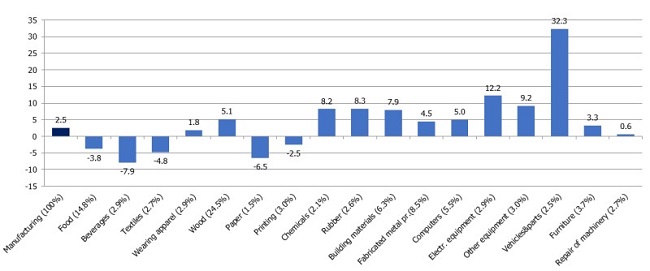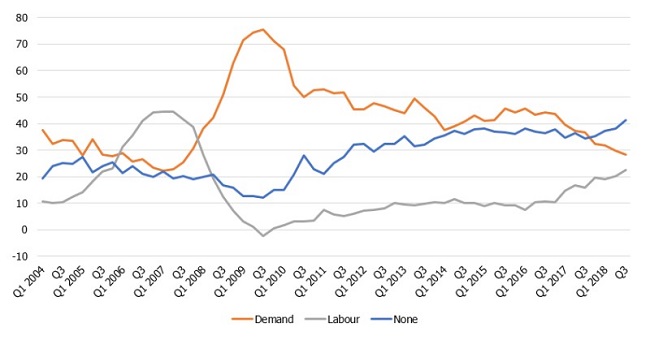Analytics, Banks, Direct Speech, Industry, Latvia
International Internet Magazine. Baltic States news & analytics
Thursday, 08.01.2026, 16:19
Manufacturing was volatile in the second quarter in Latvia
 Print version
Print version |
|---|
However, growth rates have declined overall in comparison with those recorded last year. Sentiment indicators suggest that insufficient capacity on the supply side is a significant obstacle to a more dynamic output growth.
Following a rather weak manufacturing output from January to April, manufacturing performance improved significantly in May and remained unchanged in June. Overall, in the second quarter the manufacturing output grew by 0.9% and 2.5% quarter-on-quarter and year-on-year respectively. 2017 was a particularly successful year for many sectors, e.g. the pharmaceutical sector, the producers of beverages, motor vehicles and their parts as well as the producers of high technologies. Consequently, the modest growth rates recorded this year seem weak against the previous year's high base.
Sentiment indicators show that capacity utilisation is very high and businesses increasingly report labour shortages as a factor restricting business growth. At the same time, complaints about insufficient demand for goods are less and less frequent. Thus, capacity building on the supply side will be of key importance in the future.
In the first quarter, total investment expanded at a more rapid pace, while investment in manufacturing declined. Nevertheless, the latter might pick up in the second half of the year. Over the past few months, many businesses publicly announced new investment projects: fibreboard producer Kronospan Riga will invest 100 mln euro in innovative and environmentally friendly technologies, food producer Orkla is planning to invest tens of millions of euro (the exact amount was not disclosed to the public) in the construction of a new biscuit plant, sawmill Vika Wood will invest 11 mln euro in an automated log sorting line, cement producer Cemex is planning to invest 6.8 mln euro in the modernisation of its plants this year, etc.
Investment growth in manufacturing will facilitate an improvement in the sector's performance and increase the supply of goods. Manufacturing performance will also be affected by investment in other sectors: the construction of trading centres, office buildings and infrastructure objects will boost demand for manufacturing goods such as building materials, metal structures, etc. Therefore, the dynamic growth in the construction sector in 2018 is good news for manufacturers.
Volume indices of manufacturing sub-sectors; Q2 2018 (%; y-on-y; output weights).Source: CSB

Factors restricting manufacturing (%). Source: European Commission, CSB









 «The Baltic Course» Is Sold and Stays in Business!
«The Baltic Course» Is Sold and Stays in Business!

